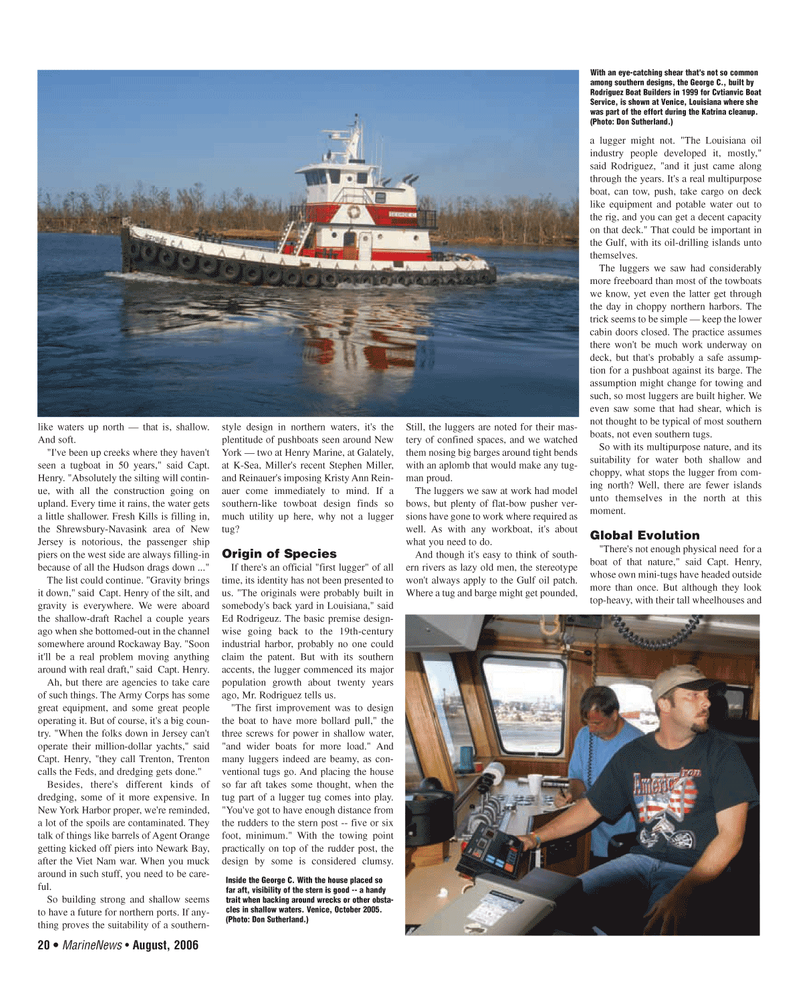
Page 20: of Marine News Magazine (August 2006)
AWO Edition: Inland & Offshore Waterways
Read this page in Pdf, Flash or Html5 edition of August 2006 Marine News Magazine
like waters up north — that is, shallow.
And soft. "I've been up creeks where they haven't seen a tugboat in 50 years," said Capt.
Henry. "Absolutely the silting will contin- ue, with all the construction going on upland. Every time it rains, the water gets a little shallower. Fresh Kills is filling in, the Shrewsbury-Navasink area of New
Jersey is notorious, the passenger ship piers on the west side are always filling-in because of all the Hudson drags down ..."
The list could continue. "Gravity brings it down," said Capt. Henry of the silt, and gravity is everywhere. We were aboard the shallow-draft Rachel a couple years ago when she bottomed-out in the channel somewhere around Rockaway Bay. "Soon it'll be a real problem moving anything around with real draft," said Capt. Henry.
Ah, but there are agencies to take care of such things. The Army Corps has some great equipment, and some great people operating it. But of course, it's a big coun- try. "When the folks down in Jersey can't operate their million-dollar yachts," said
Capt. Henry, "they call Trenton, Trenton calls the Feds, and dredging gets done."
Besides, there's different kinds of dredging, some of it more expensive. In
New York Harbor proper, we're reminded, a lot of the spoils are contaminated. They talk of things like barrels of Agent Orange getting kicked off piers into Newark Bay, after the Viet Nam war. When you muck around in such stuff, you need to be care- ful.
So building strong and shallow seems to have a future for northern ports. If any- thing proves the suitability of a southern- style design in northern waters, it's the plentitude of pushboats seen around New
York — two at Henry Marine, at Galately, at K-Sea, Miller's recent Stephen Miller, and Reinauer's imposing Kristy Ann Rein- auer come immediately to mind. If a southern-like towboat design finds so much utility up here, why not a lugger tug?
Origin of Species
If there's an official "first lugger" of all time, its identity has not been presented to us. "The originals were probably built in somebody's back yard in Louisiana," said
Ed Rodrigeuz. The basic premise design- wise going back to the 19th-century industrial harbor, probably no one could claim the patent. But with its southern accents, the lugger commenced its major population growth about twenty years ago, Mr. Rodriguez tells us. "The first improvement was to design the boat to have more bollard pull," the three screws for power in shallow water, "and wider boats for more load." And many luggers indeed are beamy, as con- ventional tugs go. And placing the house so far aft takes some thought, when the tug part of a lugger tug comes into play. "You've got to have enough distance from the rudders to the stern post -- five or six foot, minimum." With the towing point practically on top of the rudder post, the design by some is considered clumsy.
Still, the luggers are noted for their mas- tery of confined spaces, and we watched them nosing big barges around tight bends with an aplomb that would make any tug- man proud.
The luggers we saw at work had model bows, but plenty of flat-bow pusher ver- sions have gone to work where required as well. As with any workboat, it's about what you need to do.
And though it's easy to think of south- ern rivers as lazy old men, the stereotype won't always apply to the Gulf oil patch.
Where a tug and barge might get pounded, a lugger might not. "The Louisiana oil industry people developed it, mostly," said Rodriguez, "and it just came along through the years. It's a real multipurpose boat, can tow, push, take cargo on deck like equipment and potable water out to the rig, and you can get a decent capacity on that deck." That could be important in the Gulf, with its oil-drilling islands unto themselves.
The luggers we saw had considerably more freeboard than most of the towboats we know, yet even the latter get through the day in choppy northern harbors. The trick seems to be simple — keep the lower cabin doors closed. The practice assumes there won't be much work underway on deck, but that's probably a safe assump- tion for a pushboat against its barge. The assumption might change for towing and such, so most luggers are built higher. We even saw some that had shear, which is not thought to be typical of most southern boats, not even southern tugs.
So with its multipurpose nature, and its suitability for water both shallow and choppy, what stops the lugger from com- ing north? Well, there are fewer islands unto themselves in the north at this moment.
Global Evolution "There's not enough physical need for a boat of that nature," said Capt. Henry, whose own mini-tugs have headed outside more than once. But although they look top-heavy, with their tall wheelhouses and 20 • MarineNews • August, 2006
With an eye-catching shear that's not so common among southern designs, the George C., built by
Rodriguez Boat Builders in 1999 for Cvtianvic Boat
Service, is shown at Venice, Louisiana where she was part of the effort during the Katrina cleanup. (Photo: Don Sutherland.)
Inside the George C. With the house placed so far aft, visibility of the stern is good -- a handy trait when backing around wrecks or other obsta- cles in shallow waters. Venice, October 2005. (Photo: Don Sutherland.)
AUGUST MN2006 3(17-24).qxd 8/3/2006 3:31 PM Page 20

 19
19

 21
21
